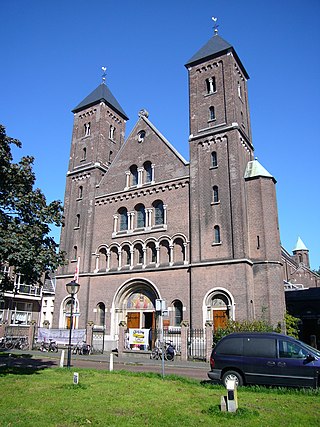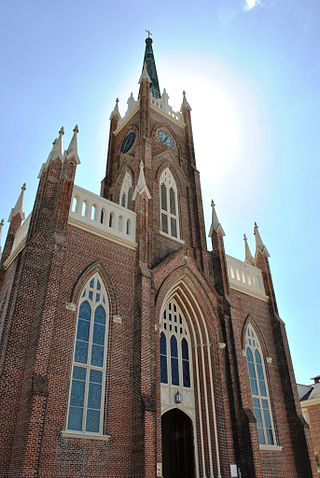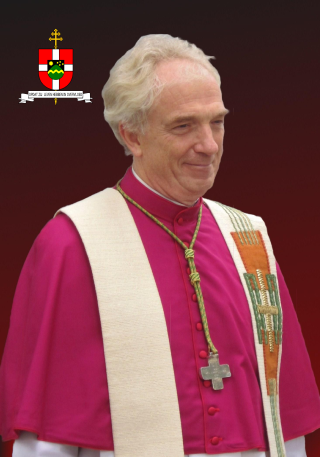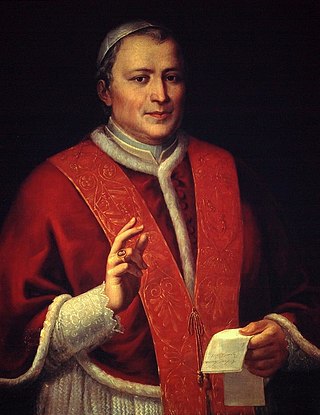Related Research Articles
The terms Old Catholic Church, Old Catholics, Old-Catholic churches, or Old Catholic movement, designate "any of the groups of Western Christians who believe themselves to maintain in complete loyalty the doctrine and traditions of the undivided church but who separated from the see of Rome after the First Vatican council of 1869–70". The expression Old Catholic has been used from the 1850s by communions separated from the Roman Catholic Church over certain doctrines, primarily concerned with papal authority and infallibility. Some of these groups, especially in the Netherlands, had already existed long before the term. The Old Catholic Church is separate and distinct from Traditionalist Catholicism.

The Old Catholic Church of the Netherlands, sometimes Jansenist Church of Holland, is an Old Catholic jurisdiction originating from the Archdiocese of Utrecht (695–1580). The Old Catholic Church of the Netherlands is the mother church of the Old Catholic Union of Utrecht.

The Archdiocese of Utrecht is an archdiocese of the Latin Church of the Catholic Church in the Netherlands. The Archbishop of Utrecht is the metropolitan of the ecclesiastical province of Utrecht. There are six suffragan dioceses of the province: Roman Catholic Dioceses of Breda, of Groningen-Leeuwarden, of Haarlem-Amsterdam, of Roermond, of Rotterdam, and of 's-Hertogenbosch. The cathedral church of the archdiocese is Saint Catherine's Cathedral, which replaced the prior cathedral, Saint Martin's Cathedral after it was taken by Protestants in the Reformation.

Johannes Zwijsen was the first Roman Catholic Archbishop of Utrecht after the reestablishment of the episcopal hierarchy in the Netherlands in 1853.

The Diocese of Haarlem–Amsterdam is a Latin diocese of the Catholic Church in the Netherlands. As one of the seven suffragans in the ecclesiastical province of the Metropolitan Archbishop of Utrecht, the diocesan territory comprises the north west of the Netherlands, including the cities of Haarlem and Amsterdam.

The Diocese of Natchez was a Latin Church diocese of the Catholic Church; it was the predecessor of the Diocese of Jackson. It served all of Mississippi until the state was split into two dioceses, Jackson and Biloxi.

The Catholic Church in the Netherlands is part of the worldwide Catholic Church under the spiritual leadership of the Pope in Rome. Its primate is the Metropolitan Archbishop of Utrecht, since 2008 Willem Jacobus Eijk. In 2015 Catholicism was the single largest religion of the Netherlands, forming some 23% of the Dutch people, based on in-depth interviewing, down from 40% in the 1960s.
In the canon law of the Catholic Church, a mission sui iuris, also known as an independent mission, can be defined as: "an ecclesial structure erected from a previous territory, with explicit boundaries, under the care of a religious community or other diocese, responding to a missionary exigency and headed by a superior nominated by the Holy See, under the aegis of the Congregation for the Evangelization of Peoples."

St. Catherine's Cathedral, Utrecht, is a Catholic church dedicated to Saint Catherine of Alexandria situated in Utrecht in the Netherlands.

Joris August Odilius Ludovicus Vercammen served as the Old Catholic Archbishop of Utrecht of the Old Catholic Church of the Netherlands from 1 July 2000 to 11 January 2020.

The Diocese of 's-Hertogenbosch is a Latin Church ecclesiastical jurisdiction or diocese of the Catholic church in the Netherlands. The modern diocese was created in 1853. It is a suffragan of the archdiocese of Utrecht. It is currently led by bishop Gerard de Korte. Its see is St John's Cathedral, 's-Hertogenbosch.

Pieter Codde also known as Petrus Codde was apostolic vicar of the Catholic Church's Vicariate Apostolic of Batavia, also known as the Dutch Mission, from 1688 to 1702. He served as the Old Catholic Archbishop of Utrecht from 1688 to 1710.

The Lordship of Utrecht was formed in 1528 when Charles V of Habsburg conquered the Bishopric of Utrecht, during the Guelders Wars.

The Bishops' Conference of the Netherlands is a permanent body within the Roman Catholic Church in the Netherlands which determines policies and directs the apostolic mission within the Netherlands. It is governed by bishops from around the country.
The historic Diocese of Utrecht was a diocese of the Latin Church of the Catholic Church from 695 to 1580, and from 1559 archdiocese in the Low Countries before and during the Protestant Reformation.

On 4 March 1853, Pope Pius IX restored the episcopal hierarchy in the Netherlands with the papal bull Ex qua die arcano, after the Dutch Constitutional Reform of 1848 had made this possible. The re-establishment of the episcopal hierarchy led to the April movement protest in 1853.
Ex qua die arcano is the incipit of the 4 March 1853 apostolic letter by which Pope Pius IX decreed the reestablishment of the episcopal hierarchy in the Netherlands. Through it, the administrative area formerly known as the Dutch Mission was divided into dioceses. Utrecht was raised, once more, to a Roman Catholic archdiocese, and received the four suffragan dioceses of Haarlem, 's-Hertogenbosch, Breda, and Roermond.
The Apostolic Vicariate of Ravenstein-Megen was a short-lived pre-diocesan Latin Catholic jurisdiction in a small southern part of the Netherlands.
The Apostolic Vicariate of Grave–Nijmegen was a short-lived pre-diocesan Latin Catholic jurisdiction in southern parts of the present Netherlands.
References
- 1 2 3 4 5 6 7 8 9 10 11 12 13 14 15
 One or more of the preceding sentences incorporates text from a publication now in the public domain : Lins, Joseph (1912). "Archdiocese of Utrecht". In Herbermann, Charles (ed.). Catholic Encyclopedia . Vol. 15. New York: Robert Appleton Company.
One or more of the preceding sentences incorporates text from a publication now in the public domain : Lins, Joseph (1912). "Archdiocese of Utrecht". In Herbermann, Charles (ed.). Catholic Encyclopedia . Vol. 15. New York: Robert Appleton Company. - ↑
 One or more of the preceding sentences incorporates text from a publication now in the public domain : Mershman, Francis (1912). "St. Willibrord". In Herbermann, Charles (ed.). Catholic Encyclopedia . Vol. 15. New York: Robert Appleton Company.
One or more of the preceding sentences incorporates text from a publication now in the public domain : Mershman, Francis (1912). "St. Willibrord". In Herbermann, Charles (ed.). Catholic Encyclopedia . Vol. 15. New York: Robert Appleton Company. - 1 2 3 4 5 "Archdiocese of Utrecht". Catholic-Hierarchy.org . David M. Cheney. Retrieved 2014-01-14.
- 1 2 One or more of the preceding sentences incorporates text from a publication now in the public domain : Edmundson, George; Phillips, Walter A (1911). "Utrecht". In Chisholm, Hugh (ed.). Encyclopædia Britannica . Vol. 27 (11th ed.). Cambridge University Press. pp. 823–824.
- 1 2
 This article incorporates text from this source, which is in the public domain : Neale, John M (1858). History of the so-called Jansenist church of Holland; with a sketch of its earlier annals, and some account of the Brothers of the common life. Oxford; London: John Henry and James Parker. hdl:2027/mdp.39015067974389. OCLC 600855086.
This article incorporates text from this source, which is in the public domain : Neale, John M (1858). History of the so-called Jansenist church of Holland; with a sketch of its earlier annals, and some account of the Brothers of the common life. Oxford; London: John Henry and James Parker. hdl:2027/mdp.39015067974389. OCLC 600855086. - ↑
 This article incorporates text from a publication now in the public domain : Hauck, Albert (1908). "Adalbold". In Jackson, Samuel Macauley (ed.). New Schaff–Herzog Encyclopedia of Religious Knowledge . Vol. 1 (third ed.). London and New York: Funk and Wagnalls. p. 32.
This article incorporates text from a publication now in the public domain : Hauck, Albert (1908). "Adalbold". In Jackson, Samuel Macauley (ed.). New Schaff–Herzog Encyclopedia of Religious Knowledge . Vol. 1 (third ed.). London and New York: Funk and Wagnalls. p. 32. - ↑ La Monte, John L (1949). The world of the Middle Ages: a reorientation of medieval history. New York: Appleton-Century-Crofts. p. 393. hdl:2027/mdp.39015024887880. OCLC 568161011.
- 1 2
 This article incorporates text from this source, which is in the public domain :Pope Leo X. Debitum pastoralis officii nobis (in Latin). From Joosting, Jan G. C.; Muller, Samuel (1912). "Verbod van Paus Leo X aan den aartsbisschop van Keulen als legatus natus, Philips bisschop van Utrecht, diens fiscus en diens kerkelijke en wereldlijke onderdanen in eerste instantie naar keulen te doen dagvaarden". Bronnen voor de geschiedenis der kerkelijke rechtspraak in het bisdom Utrecht in di middeleeuwen. Oude vaderlandsche rechtsbronnen (in Dutch). 's-Gravenhage: Martinus Nijhoff. pp. 59–62. hdl:2027/mdp.35112103682300 . Retrieved 2014-01-09. This book contains documents relating to the limit of the jurisdiction of the bishop of Utrecht. This book was published in Werken der Vereeniging tot Uitgaaf der Bronnen van het Oud-Vaderlandsche Recht. 's-Gravenhage: Martinus Nijhoff. 2(14). OCLC 765196601 .
This article incorporates text from this source, which is in the public domain :Pope Leo X. Debitum pastoralis officii nobis (in Latin). From Joosting, Jan G. C.; Muller, Samuel (1912). "Verbod van Paus Leo X aan den aartsbisschop van Keulen als legatus natus, Philips bisschop van Utrecht, diens fiscus en diens kerkelijke en wereldlijke onderdanen in eerste instantie naar keulen te doen dagvaarden". Bronnen voor de geschiedenis der kerkelijke rechtspraak in het bisdom Utrecht in di middeleeuwen. Oude vaderlandsche rechtsbronnen (in Dutch). 's-Gravenhage: Martinus Nijhoff. pp. 59–62. hdl:2027/mdp.35112103682300 . Retrieved 2014-01-09. This book contains documents relating to the limit of the jurisdiction of the bishop of Utrecht. This book was published in Werken der Vereeniging tot Uitgaaf der Bronnen van het Oud-Vaderlandsche Recht. 's-Gravenhage: Martinus Nijhoff. 2(14). OCLC 765196601 . - ↑ Edmundson, George (1922). History of Holland. Cambridge historical series. Cambridge: Cambridge University Press. LCCN 22004345.
- 1 2 3 4 5 6 7 "History". Domkerk Utrecht. Utrecht. Archived from the original on 2013-12-14. Retrieved 2014-01-16.
- 1 2
 One or more of the preceding sentences incorporates text from a publication now in the public domain : Hove, Alphonse van (1909). "Diocese". In Herbermann, Charles (ed.). Catholic Encyclopedia . Vol. 5. New York: Robert Appleton Company.
One or more of the preceding sentences incorporates text from a publication now in the public domain : Hove, Alphonse van (1909). "Diocese". In Herbermann, Charles (ed.). Catholic Encyclopedia . Vol. 5. New York: Robert Appleton Company. - 1 2 3 4 5 6 7 8 9 10 "Mission "Sui Iuris" of Batavia (Holland Mission)". Catholic-Hierarchy.org . David M. Cheney. Retrieved 2014-01-14.
- 1 2 "The hierarchy in Holland". The Tablet. London. 1953-05-16. p. 20. Archived from the original on 2014-02-01. Retrieved 2014-01-14.
- 1 2 3 4 5 6 7 8 9 10 11 12 13 14 15 16 17 18 19 20 21 22 23 24 25 26 27 28 29 30 31 "Apostolisch vicarissen van de Hollandse Zending". kdc.kun.nl (in Dutch). Nijmegen: Radboud Universiteit. Katholiek Documentatie Centrum. Archived from the original on 2007-08-05. Retrieved 2014-07-08. Transcribed from Molenaar, M. Chr. M.; Abbink, Gerhardus A. M. (1995). Dertienhonderd jaar bisdom Utrecht (in Dutch). Baarn: Uitgeverij Gooi en Sticht. p. 94. ISBN 9789030408284.
